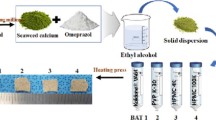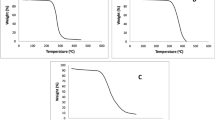Abstract
The current investigation aimed to enhance the dissolution rate and mask the bitter taste of levofloxacin by developing pharmaceutical cocrystals using stearic acid and saccharin sodium as coformers. The developed cocrystals were characterized by Fourier transform infrared spectroscopy, which showed the formation of a regular carboxylic acid homosynthon in 1:1 ratio of levofloxacin-stearic acid and carboxylic acid- imide heterosynthon in 2:1 ratio of levofloxacin-saccharin sodium. The existence of the drug in a new crystalline form in the developed cocrystals was confirmed by solid state characterization. The dissolution studies of the developed cocrystals in simulated gastric fluid (pH 1.2) showed significant improvement of the drug dissolution rate (%min−1) from L-ST1 (7.8 ± 0.1) and L-SA2 (7.2 ± 0.4) cocrystals compared to supplied levofloxacin (4.4 ± 0.3). The taste masking ability of L-ST1 and L-SA2 was determined by conducting dissolution studies at salivary pH 6.6 and the results showed a very low drug release of 6.6 ± 0.6% from L-ST1 compared to supplied levofloxacin (64.5 ± 1.5%) and L-SA2 (55.1 ± 1.5%) in 5 min. This study demonstrates that pharmaceutical cocrystals of levofloxacin with stearic acid at 1:1 ratio enhanced the dissolution rate and masked the bitter taste of levofloxacin whereas saccharin sodium has showed only improved dissolution.





Similar content being viewed by others

References
Aakeröy CB, Desper J, Salmon DJ, Smith MM (2006) Cyanophenyloximes: reliable and versatile tools for hydrogen-bond directed supramolecular synthesis of co-crystals. Cryst Growth Des 6:1033–1042
Agarwal R, Mittal R, Singh A (2000) Studies of ion-exchange resin complex of chloroquine phosphate. Drug Dev Ind Pharm 26:773–776
Ayenew Z, Puri V, Kumar L, Bansal AK (2009) Trends in pharmaceutical taste masking technologies: a patent review. Recent Pat Drug Deliv Formul 3:26–39
Basavoju S, Boström D, Velaga SP (2008) Indomethacin-saccharin cocrystal: design, synthesis and preliminary pharmaceutical characterization. Pharm Res 25:530–541
Deng Y, Chen B, Qi Y, Magdalou J, Wang H, Chen L (2011) The effects of levofloxacin on rabbit anterior cruciate ligament cells in vitro. Toxicol Appl Pharmacol 257:67–73
Drozak J, Miecznik A, Jarzyna R, Bryla J (2008) The inhibition of gluconeogenesis by gatifloxacin may contribute to its hypoglycaemic action. Eur J Pharmacol 594:39–43
Eedara BB, Bandari S (2016) Lipid-based dispersions of exemestane for improved dissolution rate and intestinal permeability: in vitro and ex vivo characterization. Artif Cells Nanomed Biotechnol. doi:10.1080/21691401.2016.1193023
Eedara BB, Kankane M, Jukanti R, Nagabandi VK, Bandari S (2013) Enhanced solubility and permeability of exemestane solid dispersion powders for improved oral delivery. J Pharm Investig 43:229–242
Eedara BB, Veerareddy PR, Jukanti R, Bandari S (2014) Improved oral bioavailability of fexofenadine hydrochloride using lipid surfactants: ex vivo, in situ and in vivo studies. Drug Dev Ind Pharm 40:1030–1043
Elder DP, Holm R, Diego HL (2013) Use of pharmaceutical salts and cocrystals to address the issue of poor solubility. Int J Pharm 453:88–100
Fleischman SG, Kuduva SS, McMahon JA, Moulton B, Walsh RDB, Rodr´ıguez-Hornedo N, Zaworotko MJ (2003) Crystal engineering of the composition of pharmaceutical phases: multiple-component crystalline solids involving carbamazepine. Cryst Growth Des 3:909–919
Kallakunta VR, Eedara BB, Jukanti R, Ajmeera RK, Bandari S (2013) A Gelucire 44/14 and labrasol based solid self-emulsifying drug delivery system: formulation and evaluation. J Pharm Investig 43:185–196
Katsuragi Y, Sugiura Y, Lee C, Otsuji K, Kurihara K (1995) Selective inhibition of bitter taste of various drugs by lipoprotein. Pharm Res 12:658–662
Koeppe MO, Cristofoletti R, Fernandes EF, Storpirtis S, Junginger HE, Kopp S, Midha KK, Shah VP, Stavchansky S, Dressman JB, Barends DM (2011) Biowaiver monographs for immediate release solid oral dosage forms: Levofloxacin. J Pharm Sci 100:1628–1636
Lachman L, Lieberman HA, Kanig JL (1987) The Theory and Practice of Industrial Pharmacy. In: Liquids. Marcel Dekker Inc, New York, pp 419–427
Maulvi FA, Dalwadi SJ, Thakkar VT, Soni TG, Gohel MC, Gandhi TR (2011) Improvement of dissolution rate of aceclofenac by solid dispersion technique. Powder Technol 207:47–54
Nanda A, Kandarapur R, Garg S (2002) An update on taste masking technologies for oral pharmaceuticals. Ind J Pharm Sci 64:10–17
Qiao N, Li M, Schlindwein W, Malek N, Davies A, Trappitt G (2011) Pharmaceutical cocrystals: an overview. Int J Pharm 419:1–11
Raghavan KS, Ranadive S, Bembenek KS, Benkerrour L, Trognon V, Corrao RG, Esposito L (2003) WO Patent 2003/000175.
Schultheiss N, Newman A (2009) Pharmaceutical cocrystals and their physicochemical properties. Cryst Growth Des 9:2950–2967
Serajuddin ATM (2007) Salt formation to improve drug solubility. Adv Drug Deliv Rev 59:603–616
Sharma S, Lewis S (2010) Taste masking technologies: a review. Int. J Pharm Pharm Sci 2:6–13
Shirai Y, Sogo K, Yamamoto K, Kojima K, Fujioka H, Makita H, Nakamura Y (1993) A novel fine granule system for masking bitter taste. Biol Pharm Bull 16:172–177
Sohi H, Sultana Y, Khar RK (2004) Taste masking technologies in oral pharmaceuticals: recent developments and approaches. Drug Dev Ind Pharm 30:429–448
Szejtli J (2004) Past, present, and future of cyclodextrin research. Pure Appl Chem 76:1825–1845
Szejtli J, Szente L (2005) Elimination of bitter, disgusting tastes of drugs and foods by cyclodextrins. Eur J Pharm Biopharm 61:115–125
Tasso L, de Andrade C, Dalla Costa T (2011) Pharmacokinetic/pharmacodynamic modelling of the bactericidal activity of free lung concentrations of levofloxacin and gatifloxacin against Streptococcus pneumoniae. Int J Antimicrob Agents 38:307–313
Tripathi A, Parmar D, Patel U, Patel G, Daslaniya D, Bhimani B (2011) Taste masking: a novel approach for bitter and obnoxious drugs. J Pharm Sci Bio-Sci Res 1:136–142
Yu X, Liu H, Sun C, Shi S, Fu X, He, Y (2012) A simple and novel method for preparing the taste masking levofloxacin microsphere suspension. Afr. J Pharm Pharmacol 6:1617–1624
Acknowledgements
The corresponding author acknowledges the financial support from Science & Engineering Research Board (File No. SB/YS/LS-119/2013), Department of Science and Technology, New Delhi, India. The authors are grateful to Dr. Reddy’s laboratories (Hyderabad, India) for the gift sample of levofloxacin. The authors thank Mrs. Rajani Nanam, Mrs. Sri Ramya and Mr. Narla Sagar for suggestions in chemical structure analysis. The authors also thank Mr. T. Jayapal Reddy, Chairman, St. Peter’s Institute of Pharmaceutical Sciences, Hanamkonda for providing the necessary facilities. The authors report no conflicts of interest. This article does not contain any studies with human and animal subjects performed by any of the authors. The authors report no conflicts of interest.
Author information
Authors and Affiliations
Corresponding author
Electronic supplementary material
Below is the link to the electronic supplementary material.
Rights and permissions
About this article
Cite this article
Bandari, S., Dronam, V.R. & Eedara, B.B. Development and preliminary characterization of levofloxacin pharmaceutical cocrystals for dissolution rate enhancement. Journal of Pharmaceutical Investigation 47, 583–591 (2017). https://doi.org/10.1007/s40005-016-0302-8
Received:
Accepted:
Published:
Issue Date:
DOI: https://doi.org/10.1007/s40005-016-0302-8



